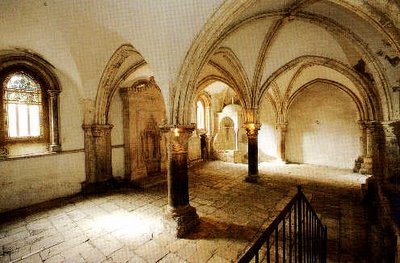
What I Saw In The Holy Land, 12
Psalm 48 describes Mt. Zion as the Lord's "holy mountain," and "joy of the whole earth," and it certainly seems thus when you consider everything that's located there. At left you see the cenacle, or upper room, scene of the Last Supper & later of Pentecost. And guess what is on the bottom floor of thus "upper room?" The traditional tomb of King David. I had no idea, but there is archaeological evidence of an ancient synagogue and Jewish veneration of the site going very far back. Apparently the wealthy friend who loaned Jesus this room made his house on the grounds of the site. Since Islam considers itself a correction of Judaism & Christianity, it also claims interest in Mt. Zion, and during Turkish rule, the cenacle was made part of a mosque which is no longer in use.
The entire mountain (which seems more like a hill now because so much has built up at its base) is filled with yeshivas of various provenance, as this is one of Judaism's holiest sites. Oskar Schindler is buried here, with the inscription "righteous gentile" over his gravesite.
Also on Mt. Zion are two churches of interest. The Benedictine Dormition Abbey is the place where Mary is said to have died --the tradition is that she made her home near the site of the cenacle after the Resurrection.
 See the guy in the bottom left of the picture? Just a few feet further in the direction he's heading and across the way is the entrance to David's tomb. To reach the cenacle, you walk a little further still and round the corner to the left to enter. The cenacle itself is open to Christian tourists, but is Jewish controlled. (Last year I blogged about a deal the Vatican struck to trade control of the cenacle for an ancient Jewish synagogue in Toledo, but it was scuttled in the face of strong objections from some Jewish groups.)
See the guy in the bottom left of the picture? Just a few feet further in the direction he's heading and across the way is the entrance to David's tomb. To reach the cenacle, you walk a little further still and round the corner to the left to enter. The cenacle itself is open to Christian tourists, but is Jewish controlled. (Last year I blogged about a deal the Vatican struck to trade control of the cenacle for an ancient Jewish synagogue in Toledo, but it was scuttled in the face of strong objections from some Jewish groups.)Lower down on Mt. Zion is the Church of Peter in Gallicantu (cock's crow), which is built on the site of Caiaphas' palace. The grounds of this Church are the best place to take pictures of the Mt. of Olives and the Kidron Valley, and there's also a wonderful scale model of the Cld City of Jerusalem that will show you how the city would have looked in Christ's time.
 Caiaphas' palace is fascinating; like most of the ancient sites in and around Jerusalem, his house was a cave complex, and underneath the offices and living quarters was a series of dank lower caves that were used as a jail at the time. It is thought that Christ spent the night here in Caiaphas' dungeon after his arrest --in the very lowest pit, reserved for the worst criminals. Hard in this spot not to be reminded of Joseph's brothers lowering him into a pit, and seeing again how utterly Christ fulfilled the Old Testament prophecies and prefigurements concerning him.
Caiaphas' palace is fascinating; like most of the ancient sites in and around Jerusalem, his house was a cave complex, and underneath the offices and living quarters was a series of dank lower caves that were used as a jail at the time. It is thought that Christ spent the night here in Caiaphas' dungeon after his arrest --in the very lowest pit, reserved for the worst criminals. Hard in this spot not to be reminded of Joseph's brothers lowering him into a pit, and seeing again how utterly Christ fulfilled the Old Testament prophecies and prefigurements concerning him.
